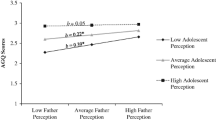Abstract
An empirically-based theory identifies a systemic parent-adolescent conflict process as the major influence in the unacceptable behavior of adolescents fromgood-enough families. Qualitative research about concerned parents of acting-up teenagers provides: (1) a profile of the characteristics of the parents; (2) a multi-dimensional view of parental competence; (3) an analysis of the main components of the parent-adolescent conflict process; and, (4) a theory that perceived vulnerability provides a context in which the conflict process thrives. Practice implications of the theory, based on self-help group and clinical use, are shared.
Similar content being viewed by others
References
Anderson, K. E., Lytton, H., & Romney, D. (1986). Mothers' interactions with normal and conduct-disordered boys: Who affects whom?Developmental Psychology, 22, 604–609.
Bayard, R. T., & Bayard, J. (1981).How to deal with your acting-up teenager. New York: M. Evans.
Belsky, J., Robins, E., & Gamble, W. (1984). The determinants of parental competence: Toward a contextual theory. In M. Lewis (Ed.),Beyond the Dyad. New York: Plenum Press.
Bibby, R. W., & Posterski, D. C. (1985).The emerging generation: An inside look at Canada's teenagers. Toronto: Irwin.
Bienstock, C. (1988).Predictors of coping for divorced single parent mothers. Paper presented at the 65th Annual Meeting of the American Orthopsychiatric Association. San Francisco.
Bowen, M. (1986). The use of family theory in clinical practice.Comprehensive Psychiatry, 7, 345–374.
Caplan, P. J., & Hall-McCorquodale, I. (1985a). Mother blaming in major clinical journals.American Journal of Orthopsychiatry, 55, 345–353.
Caplan, P. J., & Hall-McCorquodale, I. (1985b). The scapegoating of mothers: A call for change.American Journal of Orthopsychiatry, 55, 610–613.
Carter, E. A., & McGoldrick, M. (Eds.) (1980).The family life cycle: A framework for family therapy. New York: Gardner.
Charles, A. V. (1986). Physically abused parents.Journal of Family violence, 1, 343–355.
Chess, S., & Thomas, A. (1986).Temperament in clinical practice. New York: Guildford.
Combrinck-Graham, L. (1987). Children, adolescents and psychiatric hospitalization.Newsletter of the American Family Therapy Association, 30 (Winter), 3–5.
Csikszentmihalyi, M., & Larson, R. (1984).Being adolescent: Conflict and growth in the teenage years. New York: Basic Books.
Foss, H. (1984).Exploring the effectiveness of a self-help group—Toughlove. Unpublished Manuscript, University of Winnipeg.
Fried, M. (1982). Endemic stress: The psychology of resignation and the politics of scarcity.American Journal of Orthopsychiatry, 52, 4–19.
Glaser, B. G., & Strauss, A. L. (1967).The discovery of grounded theory. New York: Aldine.
Gross, Z. H. (1985).And you thought it was all over: Mothers and their adult children. New York: St. Martins Press.
Haley, J. (1980).Leaving home: The therapy of disturbed young people. New York: McGraw-Hill.
Hall, J. A. (1984). Empirically based treatment for parent-adolescent conflict.Social Casework: The Journal of Contemporary Social Work, 74, 487–495.
Hallowitz, D., & Stulbertg, B. (1959). The vicious cycle in parent-child relationship breakdown.Social Casework, XL, 268–275.
Hoffman, L. (1971). Deviation amplifying processes in natural groups. In J. Haley (Ed.),Changing families: A family therapy reader (pp. 285–311). New York: Grune & Stratton.
Hill, R. (1965). Generic features of families under stress. In H. J. Parad (Ed.),Crisis intervention: Selected readings (pp. 32–52). New York: Family Service Association of America.
Johnstone, J. W., & Johnstone, N. J. (1980). Families, communities and rebellious adolescents. In M. Sugar (Ed.),Responding to adolescent needs. New York: SP Medical and Scientific Books.
Jones, V. F. (1980).Adolescents with behavior problems: Strategies for teaching, counseling and parent involvement (abridged ed.). Boston: Allyn and Bacon.
Leveton, E. (1984).Adolescent crisis: Family counseling approaches. New York: Springer.
Madanes, C. (1981).Strategic family therapy. San Francisco: Jossey-Bass.
Minuchin, S. (1974).Families and family therapy. Cambridge, MA: Harvard University Press.
Munuchin, S., Rosman, B. L., & Baker, L. (1978).Psychosomatic families: Anorexia nervosa in context. Cambridge, MA: Harvard University Press.
Montemayor, R. (1983). Parents and adolescents in conflict: All families some of the time and some families most of the time.Journal of Early Adolescence, 3, 83–103.
Oldham, D. G. (1980). Adolescent turmoil: A myth revisited. In M. Bloom (Ed.).Life span development: Bases for preventive and interventive helping. New York: MacMillan.
Olson, D. H., Russell, C., & Sprenkle, D. H. (1983). Circumplex model of marital and family systems: Theoretical update.Family Process, 22, 69–83.
Olson, D. H., Sprenkle, D. H., & Russell, C. (1979). Circumplex model of marital and family systems: 1. Cohension and adaptability dimensions, family types and clinical applications.Family Process, 18, 3–28.
Pilisuk, M. (1982). Delivery of social support: The social inoculation.American Journal of Orthopsychiatry, 52, 20–31.
Schwartz, H., & Jacobs, J. (1979).Qualitative sociology: A method to madness. New York: Free Press.
Strommen, M., & Strommen, I. (1985).Five cries of parents. San Francisco: Harper and Row.
Tomlinson, L. E. (1982).Tomlinson parent support group model. Calgary, AB: Unpublished manuscript.
Tomlinson, L. E. (1988).The PARENT CONNECTION program. Calgary, AB: Unpublished manuscript.
Tomlinson, R. K. (1984). Parent-adolescent conflict: A lesson for professionals. InChanging values: Implications for family policy and practice. Proceedings of Conference '84, Second National Annual Conference of Family Service Canada, Montreal.
Tomlinson, R. K. (1987).Living with parent-adolescent conflict. Paper presented at The Family in Motion Symposium: A Dialogue on Families in Canada. The Family Services of Winnipeg, MA.
Tomlinson, R. K. (1990).A clinical approach to parent-adolescent conflict. Manuscript submitted for publication.
Turecki, S., & Toner, L. (1985).The difficult child. Toronto: Bantam Books.
Viorst, J. (1986).Necessary losses. New York: Random House.
Winnicot, D. W. (1958).Collected papers. New York: Basic Books.
Winnicot, D. W. (1965).The maturational processes and the facilitating environment. New York: International Universities Press.
York, P., York, D., & Wachtel, T. (1982).Toughlove. New York: Doubleday.
Author information
Authors and Affiliations
Rights and permissions
About this article
Cite this article
Tomlinson, R.K. Unacceptable adolescent behavior and parent-adolescent conflict. Child Adolesc Soc Work J 8, 33–51 (1991). https://doi.org/10.1007/BF00757540
Issue Date:
DOI: https://doi.org/10.1007/BF00757540




